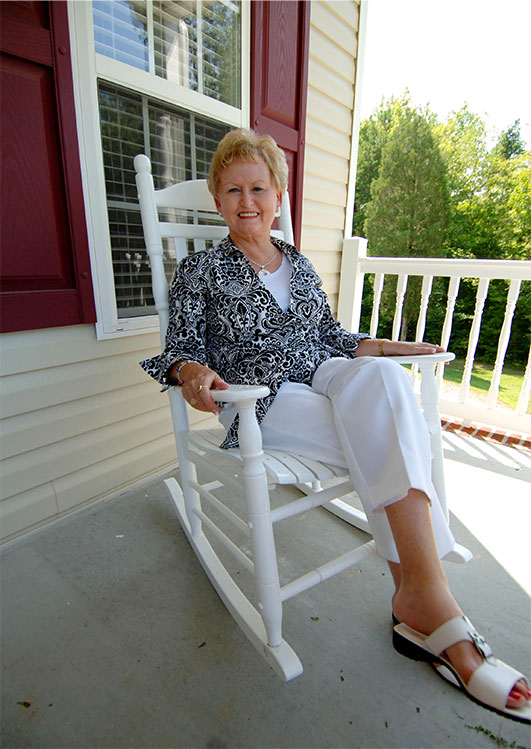by Vance R. Parker JD, MBA | May 28, 2019

WTOB FM/AM Radio in Winston-Salem, NC interviews elder, special needs, and estate planning attorney Vance Parker as he explains how the new North Carolina Uniform Power of Attorney Act (enacted December 2018) may have made your existing financial power of attorney document deficient (or obsolete) for many later elder law, Medicaid planning, or asset protection needs.
Now-deficient powers of attorney, such as the once popular North Carolina Statutory Short Form Power of Attorney that many people still use today, can cause great problems when a person is later diagnosed with a dementia or becomes mentally impaired so that use of the financial power of attorney is needed to make critical financial, legal, Medicaid planning, or asset protection decisions. Such decisions may later be required in order to protect the senior’s home and other assets from Medicaid estate recovery, or from medical creditors. When the senior or disabled person’s financial power of attorney is deficient, key decisions that the agent must make to financially or legally protect the senior may now need to be first approved by the county Clerk of Superior Court, which can be an expensive, time consuming, and unpredictable process.
Adding an inexpensive financial power of attorney document containing detailed elder law powers (an Elder Law Power of Attorney) to one’s estate documents in the first place, while a person is still healthy to sign such documents, can prevent all of the problems caused by the new NC Power of Attorney Act. With an Elder Law Power of Attorney, the senior or disabled person’s agent will have all of the tools (if needed later) to legally protect the senior’s assets, so that critical Medicaid planning or asset protection decisions can be made quickly to save the senior’s home and assets for the senior, spouse, and family, without having to go to the county Clerk of Superior Court for permission first.
Vance talks with WTOB Radio every Tuesday at 4:38 pm, educating the public about elder and special needs law, and estate planning topics.
by Vance R. Parker JD, MBA | Dec 27, 2017

CATEGORIES: Elder Law, Medicaid Planning, Winston Salem, North Carolina, NC.
Many individuals or couples must apply to Medicaid to finance nursing home or other long-term care costs. Medicaid planning allows an individual or couple to shelter their assets from Medicaid, while simultaneously “spending down” to meet strict Medicaid asset requirements.
When a Medicaid applicant must move quickly to spend down assets, a properly drafted Medicaid Promissory Note may preserve valuable funds for the applicant(s), rather than losing these assets to pay for facility costs.
Congress Created a “Safe Harbor” With Respect to Medicaid for Drafting Promissory Notes
Congress, in passing the federal Deficit Reduction Act (DRA) of 2005, provided legislative permission for Medicaid applicants to use “Medicaid-qualified” promissory notes. As long as a promissory note meets the following requirements, it will be viewed as a permissible compensated transfer, and not penalized as a gift transfer. Such Medicaid qualified promissory notes must be:
- Irrevocable, and cannot be cancelled if the lender dies
- Divided into equal payments
- Payable within the lender’s actuarial life expectancy
The North Carolina Medicaid Manual, which Medicaid caseworkers use to evaluate Medicaid applicants, is consistent with federal law in allowing properly drafted promissory notes.
The Medicaid Promissory Note technique for sheltering assets from Medicaid was upheld in federal court in Lemmons v. Lake (U.S. Dist. Ct., W.D. Okla., No. CIV–12–1075–C, March 21, 2013). Juanita Lemmons, a resident of Oklahoma, transferred her Edward Jones account and her farm to her son, in exchange for a promissory note in the amount of $86,400, before applying for Medicaid benefits in Oklahoma. The State of Oklahoma Medicaid agency denied resident Juanita Lemmon’s Medicaid application largely because it ruled that the asset transfer was a “sham transaction.” The Oklahoma federal district court overruled that decision, holding that Mrs. Lemmons’ asset transfer was not a sham transaction, because an enforceable promissory note governed and memorialized the transaction.
How the Medicaid Promissory Note Works
The basic promissory note concept is pretty simple: the Medicaid applicant, or her spouse, acts like a bank “lender,” making a loan for the full (or partial) amount that Medicaid requires her to “spend down” in order to qualify for Medicaid. The “borrower” must be a non-spouse third party, such as a child. Both lender and borrower sign the loan document, called a Medicaid Promissory Note, where the borrower agrees to pay the Medicaid applicant back every month at the same monthly rate, over a scheduled period of time, with interest.
Here is an example of how the Medicaid Promissory Note works:
Married Mom, Jenny, suffers from congestive heart failure and has received an FL-2 form from her physician stating that she requires “SNF”, or Skilled Nursing Facility care, a medical term for “nursing home” care.
Jenny and her husband Tom have very modest assets and decide that they need to apply for Medicaid, before she can commit to the nursing home (which costs $7,000/month).
Jenny moves her assets over to her husband Tom, as allowed by Medicaid. When Jenny and Tom apply for Medicaid assistance, their Medicaid caseworker determines that Tom holds $4,600 more assets than his Medicaid Community Spouse Resource Allowance (CSRA) allows.
Thus, in Medicaid terms, Jenny and Tom are $4,600 “over resource”, meaning that they have $4,600 too many countable assets for Jenny to be accepted by Medicaid. Medicaid may then direct the couple to “spend down” the $4,600 (which could mean private-paying this money to Jenny’s nursing home in the first month). Unfortunately, however, once Jenny and Tom use the $4,600 to pay the nursing home, the money is gone to Jenny and Tom and can no longer benefit them personally.
Instead of losing the $4,600 to the nursing home, Jenny and Tom could instead choose to preserve those assets for their later use, or her family’s later use, by using the Medicaid Promissory Note to shelter those assets from Medicaid. Since Tom now holds the couple’s assets, he asks his elder law attorney to set up a Medicaid Promissory Note for a $4,600 loan amount to Tom’s (and Jenny’s) son Chuck.
The attorney determines that Tom’s actuarial life expectancy (Tom is 82 years old) is 8.58 years, and also determines an IRS-appropriate lending rate for intra-family loans at 2.54%. He structures a 96-month loan (a loan term within Tom’s actuarial life expectancy), where the $4,600 Tom loans to Chuck will be paid back by Chuck to Tom at a rate of $53.00/month ($52.95 principal + $0.11 interest.)
The IRS will count $0.11 of each month’s payment as Tom’s earned interest, with $52.95 of each month’s payment a non-taxable return of loan principal. The IRS will require Tom to report the interest payments he receives from Chuck as taxable income.
When Tom and Chuck sign the Medicaid Promissory Note, Tom writes a check to son Chuck for $4,600, which Chuck deposits in his bank account. Because the Medicaid Promissory Note represents a market interest rate compensated transaction, it is not a gift under Medicaid’s 5-year lookback rules, making the Medicaid Promissory Note a quick and easy “last minute” method of sheltering assets when applying for Medicaid.
Under standard accounting rules, the funds that Chuck owes Tom would normally remain Tom’s assets (Tom’s note receivable and Tom’s interest receivable.) Medicaid does not follow standard accounting rules regarding certain types of loans, such as the Medicaid Promissory Note, however. Under Medicaid rules, once the Promissory note is signed, the $4,600 is no longer the lender’s (Tom’s) asset. Thus Tom and Jenny can use this technique to remove $4,600 from their net Medicaid countable assets.
Jenny and Tom have thus saved $4,600 for their use that will not be lost to a facility payment. Because the Medicaid Promissory Note has constructively created an immediate spenddown for the $4,600 that the couple was over resource, their net countable assets have now been lowered by $4,600, so that Jenny can now be accepted by Medicaid. Thus, Medicaid will be then responsible for paying the $4,600 facility fees, not Jenny.
In another departure from standard accounting rules, the entire stream of monthly return of loan principal and interest income payments that Tom receives from son Chuck will all be cumulatively viewed by Medicaid as “income” to Tom. But because this will be the “community spouse’s” (Tom’s) income, not the applicant spouse’s (Jenny’s) income, this “income” can be saved by the couple, and will not be required to be spent on facility fees.
The 2005 DRA requires that the Medicaid Promissory Note cannot be cancelled at the lender’s death. Thus, if Tom dies before the 96-month loan term has ended, Chuck technically still owes the loan principal and interest balance to Tom’s estate. This note may never be called following Tom’s death, however, because North Carolina probate rules have very specific requirements and deadlines for creditors’ claims. These deadlines frequently are missed by creditors of small or insolvent estates.
by Vance R. Parker JD, MBA | Nov 28, 2017

CATEGORIES: Elder Law, Medicaid Planning, Estate Planning, Creditor Protection, Asset Protection Trust, Irrevocable Trust, Trusts, Advance Planning, Winston Salem, North Carolina, NC.
An irrevocable Asset Protection Trust (APT) may be used as part of an advance asset protection planning strategy, to help a client create a “nest egg” of assets to be passed to his loved ones free from the claims of unforeseen future creditors. Such trusts can help protect estates against large future medical care bills, such as bills from Medicaid Estate Recovery, hospital, or nursing home bills, or other unforeseen future liabilities such as legal liabilities, auto accidents, financial liabilities, bankruptcy, or can provide financial protection from nefarious family members.
In order to create an APT free from unknown future creditors in North Carolina, the trust must be designed so that the trust grantor, who sets up the trust, does not benefit directly from the trust assets. The trust beneficiaries, however, may benefit from APT assets during the grantor’s lifetime—in fact the APT may be set up to start benefitting a spouse (see item 4 below), children, or other beneficiaries immediately.
When the client’s estate is large enough to make a gifting strategy useful, it may make more sense to set up an APT instead. The StepAPT™ asset protection trust is designed to protect close family members, and provides these benefits:
- The StepAPT™ Can Provide Creditor Protection to The Grantor. Making a proper transfer into the StepAPT™ is legally very similar to making a gift to a family member. Once the grantor properly transfers assets into the StepAPT™, North Carolina and federal law considers this a transfer out of the grantor’s estate for creditor purposes, and future creditors such as Medicaid or hospitals cannot legally reach the assets in the APT.
- The StepAPT™ Can Provide Creditor Protection to Trust Beneficiaries. The StepAPT™ may be set up to provide creditor protection to trust beneficiaries both during the grantor’s life, and after the grantor’s death.
- A Beneficiary May Serve as His or Her Own Trustee. If appropriate, a non-grantor beneficiary can be set up as Trustee, so that he or can distribute assets to himself or herself according to the terms of the trust, while still retaining valuable creditor protection.
- The StepAPT™ May Be Set Up to Protect Spouses. If the Grantor has enough assets so that the need to use Medicaid to pay for long term care is not likely, the StepAPT™ may be set up to benefit and protect a grantor’s spouse. Spouses can decide to set up asset protection trusts for each other.
- The StepAPT™ Provides a Step Up in Tax Basis Which Can Greatly Reduce Taxes on Appreciated Assets. Transferring appreciated assets by gift, like a house, family farm, or stocks that have appreciated, can cause the gift recipient to pay capital gains taxes on all of the increase in value during the giver’s lifetime, which can total thousands of dollars, or more. Putting assets in a StepAPT™ asset protection trust, however, provides a step up in basis to the beneficiary, so that all of the capital gains accumulated during the grantor’s lifetime are erased. The beneficiary then only owes capital gains taxes for asset appreciation between the time that the grantor dies, and the time that the beneficiary sells the asset.Here is an example of how important getting a step up in basis can be: Suppose Dad bought a family farm in 1945 for $50,000. That farm then increases in value so that it is worth $500,000 in 2017. Then Dad gifts the farm away to son Bob in 2017, and Dad dies on January 1, 2018. If son Bob then sells the farm, at a 15% federal capital gains tax rate Bob would have to pay the IRS $67,500 in capital gains taxes for the farm’s appreciation during Dad’s life.If Dad would have benefitted Bob by placing the family farm in the StepAPT™ instead of making the gift to Bob, Bob would have received the step up in basis, the $67,500 would be erased, and the family would have saved $67,500 in income taxes.
- Not a Medicaid Asset. Any assets placed into the StepAPT™ are not countable as Medicaid assets, thus are protected from Medicaid. But because the StepAPT™ is an advance planning tool, and Medicaid considers transfers into an irrevocable trust as gift transfers, assets must be transferred into the StepAPT™ more than 5 years before the grantor uses Medicaid, to avoid penalties. The StepAPT™ should not be set up to benefit spouses when Medicaid may later be needed.
- The StepAPT™ Avoids Probate. Assets placed in the StepAPT™ do not pass through probate following the grantor’s death, making the surviving family’s job easier.
- The StepAPT™ May Reduce Income Taxes. The StepAPT™ is designed as a grantor trust, which means that income taxes paid by the trust are taxed at the grantor’s individual tax rate during the grantor’s lifetime, which is normally lower than a trust tax rate.
When using an APT, such as the StepAPT,™ it is important to plan early. An APT may not protect against any creditor already known prior to moving assets into an APT. Planning early helps assure that assets placed in an APT will be protected against any unknown future creditors, both under North Carolina and federal law.
USING A StepAPT™ WITH A REVOCABLE TRUST
The different, popular Revocable Living Trust (RLT) does not protect trust assets from the grantor’s creditors during the grantor’s life, or from estate creditors immediately following his death. But a revocable trust does allow the grantor to easily pull assets out of the trust at any time to benefit him during his life. An irrevocable StepAPT,™ cannot benefit the grantor during life, but it can protect against creditors both during life and following death.
A flexible estate planning strategy may include forming both a revocable living trust and a StepAPT™ for the client, allowing the client to utilize the best features of each type of trust. If a client has a downturn in health, or for any other reason, the revocable trust trustee may flexibly protect any amount of assets at any time by moving them from the revocable trust to the StepAPT™.
by Vance R. Parker JD, MBA | Oct 5, 2017

CATEGORIES: Elder law, medicaid planning, spend down, asset protection, Winston Salem, North Carolina, NC.
Medicaid Compliant Annuities (MCAs) provide the Medicaid planning attorney with a way to convert countable Medicaid assets into exempt Medicaid assets, creating an income stream for the applicant or his/her spouse. The MCA may be used to quickly “spend down” the Medicaid applicant’s (or the community spouse’s) assets, in order to preserve the family’s funds while qualifying the applicant for Medicaid.
Congress Created a “Safe Harbor” With Respect to Medicaid for Medicaid Compliant Annuities (MCAs)
Congress, in passing the Omnibus Reconciliation Act of 1993 (OBRA), and the federal Deficit Reduction Act (DRA) of 2005, provided legislative permission for Medicaid applicants to utilize Medicaid Compliant Annuities (MCAs). As long as a MCA meets the following requirements, it will be viewed to be exempt as a Medicaid asset. As stated within OBRA and the DRA, Medicaid Complaint Annuities must be:
- Irrevocable, and non-assignable
- Have no cash value
- Be payable within the life expectancy of the annuitant
- Have equal monthly payments, with no delay in payments, and no balloon payments
- Must name the state as the irrevocable beneficiary after the death of the annuitant
How Medicaid Countable Asset Limits are Calculated
When one member of a couple must apply to Medicaid to finance nursing home or long term care expenses in North Carolina, both members of the couple must meet certain asset restrictions. In general, the long term care applicant must not have more than $2,000 in individual countable assets when applying for Medicaid.
The spouse remaining at home is allowed to keep more assets. In North Carolina, the stay-at-home, or “community” spouse may keep a maximum of $120,900 and a minimum of $24,180 in countable assets (2017 figures) when his or her spouse is applying for Medicaid. The amount of countable assets that the community spouse may hold is called the “Community Spouse Resource Allowance,” or CSRA.
In order to calculate the exact CSRA for a particular community spouse, Medicaid performs an assessment of the applicant couple’s combined joint countable assets as of the “snapshot date.” Medicaid determines the snapshot date based on when the Medicaid applicant spends 30 consecutive days in a hospital or nursing home (“continuous period of institutionalization” or CPI.) The “snapshot date” is the last day of the month prior to the month when the applicant was first hospitalized, and/or transferred to a nursing home, for 30 consecutive days.
The snapshot date stays fixed in time based on events only, and remains the same date no matter when the actual Medicaid application is filed (i.e. the Medicaid application may be filed years after the snapshot date.)
After the snapshot date is determined, the applicant couple’s total combined countable assets on the snapshot date are divided by two. I’ll use an example to explain how the at-home spouse’s final CSRA (again the amount of countable assets Medicaid will allow the at-home spouse to keep) is calculated:
Suppose a married North Carolina Medicaid applicant couple has $280,000 in combined countable assets as of the snapshot date. Total combined countable assets are divided by two as the first step in determining the CSRA, i.e. $280,000/2 = $140,000. Because the CSRA is capped at $120,900 in North Carolina, and $140,000 is greater than $120,900, the actual CSRA (again the amount of countable assets Medicaid will allow the at-home spouse to keep) equals the maximum CSRA cap of $120,900.
How a Medicaid Annuity Can Shield and Protect Assets
In the above example, because Medicaid will only allow the ill applicant spouse to keep $2,000, and the at-home spouse to keep $120,900, with the couple’s actual combined countable assets at $280,000, Medicaid will require the couple to “spend down” $280,000 – $2,000 – $120,900 = $157,100 before the ill spouse will qualify for Medicaid.
If the couple does not do any Medicaid planning with a qualified attorney, the couple (and their extended family) may effectively lose the benefit of all or part of their $157,100 in assets, because the Medicaid 5-year lookback penalty will prevent the $157,100 from being gifted to children or other family members (thus the $157,100 may have to be unnecessarily spent by the couple on “private pay” facility costs.) Since the couple will remain on a tight budget, losing the $157,100 may jeopardize the at-home spouse’s future standard of living.
A Medicaid planning attorney works with the couple to preserve as many assets as possible. Fortunately in the above case, instead of spending down and losing the benefit of the $157,100, the Medicaid planning attorney may help the applicant couple to protect and keep the $157,100 by converting it into a non-countable exempt asset (or assets.)
A “Medicaid Compliant Annuity,” or MCA, pays interest like a normal annuity, but is a non-countable, exempt Medicaid asset. As long as the above couple’s $157,100 is liquid enough to be converted to a Medicaid annuity, instead of spending down and losing the $157,100, the couple can instead keep all of that money by investing it in the MCA, making those formerly countable assets now essentially invisible to Medicaid.
The Medicaid Compliant Annuity is owned by the couple just like any other typical investment security, but it does have transfer on death (TOD) beneficiary restrictions. The State of North Carolina’s Medicaid program must be named primary TOD beneficiary, unless the following persons are named primary TOD beneficiary, in which case Medicaid is named contingent TOD beneficiary:
- The community spouse (at-home spouse);
- A child of the couple under age 21; or
- A disabled child of any age.
To get around these TOD beneficiary restrictions, elder law attorneys frequently choose an annuity with a very short term (for example, six months, or one year.)
MCAs may be particularly useful in converting countable IRA, 401K, or other retirement account assets into Medicaid exempt assets. It is normally difficult to convert retirement account assets to other types of Medicaid exempt assets because of the need to liquidate (and incur tax penalties) the retirement account to purchase other non-security Medicaid exempt assets (such as home improvements, for example.) But because a MCA is an investment security, the assets held in a Medicaid countable retirement account may be converted to a exempt Medicaid asset within the tax-deferred retirement account (with the individual annuity payments payable out of the account to the individual Medicaid applicant or the community spouse).
References:
Krause Financial Services; David Zumpano, Esq., CPA, Lawyers With Purpose
by Vance R. Parker JD, MBA | Aug 30, 2017
 CATEGORIES: Elder Law, Medicaid Planning, Crisis Planning, Advance Planning, Asset Protection, Trusts, Nursing Home, Long Term Care, Elder Care Attorney, Medicaid Estate Recovery, Winston Salem, North Carolina, NC.
CATEGORIES: Elder Law, Medicaid Planning, Crisis Planning, Advance Planning, Asset Protection, Trusts, Nursing Home, Long Term Care, Elder Care Attorney, Medicaid Estate Recovery, Winston Salem, North Carolina, NC.
A MAPT MAY PROTECT A HOME WITH A MORTGAGE FROM MEDICAID ESTATE RECOVERY
It’s often essential to protect an older person’s home from Medicaid Estate Recovery, particularly if the older person could eventually need Medicaid to pay for long term care. As part of an elder law “proactive planning” process, a home with a mortgage can be placed in a “Medicaid Asset Protection Trust,” or “MAPT,” to keep it out of the reach of Medicaid Estate Recovery, while still allowing the senior(s) to remain in the home and the mortgage to be paid normally. Because the MAPT is a “grantor trust,” where the senior who sets it up still benefits from the home, under the Garn-St. Germain Depository Institutions Act of 1982, placing the home in the MAPT does not trigger the “due on sale clause” contained in most mortgages.
OTHER COMMON REAL ESTATE ASSET PROTECTION STRATEGIES MAY NOT WORK WHEN A MORTGAGE IS INVOLVED
Homes with mortgages may be excluded from other types of elder law creditor protection strategies (such as gifting, life estate deeds, and right of survivorship deeds.) Because of the due on sale clause, and other provisions in their mortgage contract, homeowners with mortgages may not be able to give their home away, give part of their home away, or sell or transfer their home prematurely during their lifetimes while the mortgage remains in place. If they do, their entire mortgage balance may become immediately due and payable at once. Whether the due on sale clause will or will not apply in a particular instance requires an individual legal analysis under the Garn-St. Germain Depository Institutions Act.
A MAPT MAY BE USEFUL FOR TRANSFERRING APPRECIATED ASSETS TO CHOSEN HEIRS
When appropriate, seniors may utilize a MAPT to create a “nest egg” of protected assets that they want safely passed down to their heirs, potentially free from Medicaid Estate Recovery following the senior’s death. The MAPT works well with assets, such as real estate, which have increased in value during the senior’s lifetime, because the senior’s chosen heirs will receive a stepped-up capital gains tax basis in any assets transferred to the chosen heirs at death. This means that the chosen heirs will not have to pay capital gains taxes for asset appreciation during the senior’s lifetime, which may save the children or other heirs from having to pay potentially thousands of dollars in unnecessary capital gains taxes.
PROPER USE OF THE MAPT FOR PROTECTING A HOME WITH A MORTGAGE REQUIRES PROACTIVE PLANNING
Even though using a MAPT may provide a potential option for protecting a home (or other real estate) with a mortgage from Medicaid Estate Recovery and other creditors, the home should be placed in the MAPT at least 5 years in advance of needing Medicaid to pay for long term care. Using the MAPT to protect a senior’s home with a mortgage from Medicaid Estate Recovery remains an important tool in the elder law proactive Medicaid planning process. The MAPT may be more limited, however, in protecting the home from future federal bankruptcy creditors.
by Vance R. Parker JD, MBA | Aug 3, 2017

CATEGORIES: Elder Law, Medicaid Planning, Crisis Planning, Advance Planning, Asset Protection, Nursing Home, Long Term Care, Elder Care Attorney, Medicaid Estate Recovery, Winston Salem, North Carolina, NC.
Seniors who must use Medicaid to finance their long-term care, risk losing their home to Medicaid estate recovery following their death, or following the death of their spouse. In Medicaid estate recovery, Medicaid bills the Medicaid recipient’s estate for every dollar spent on the Medicaid recipient during life. Because such bills can reach several hundred thousand dollars in size, the senior’s home may need to be sold in probate to pay all or part of the Medicaid bill.
CAREGIVER CHILD EXCEPTION
A caregiver child who lives with the senior for two years prior to the Medicaid recipient’s institutionalization may keep the home away from Medicaid estate recovery, at least while that child remains in the home. The caregiver child must have provided care that may have delayed the recipient’s admission to a nursing home or other medical institution. Such a child who meets these conditions may continue to live in the home as long as needed free of Medicaid estate recovery. If the child moves out of the home, however, the state can then legally initiate estate recovery.
RESIDENT SIBLING EXCEPTION
A sibling who continues to reside in the senior’s home following the senior’s institutionalization may also save the home from Medicaid estate recovery. Such a sibling must have an equity interest in the home, and must have lived there for at least one year before the deceased Medicaid recipient was institutionalized. As with the caregiver child above, if the qualifying sibling moves out of the home, the state can then legally initiate estate recovery.
SPOUSE, CHILD UNDER AGE 21, AND BLIND OR PERMANENTLY DISABLED CHILD EXCEPTIONS
The home is protected, and Medicaid estate recovery is prohibited, if the deceased Medicaid recipient is survived by: 1) a spouse; 2) a child under age 21; or 3) a blind or permanently disabled child of any age. All three categories of survivors are not required to live in the home, and may do what they wish with the home following the Medicaid recipient’s death.
ELDER LAW METHODS
An elder lawyer may incorporate other methods to prevent Medicaid estate recovery of the home, including utilizing a specialized deed such as a joint with right of survivorship (JTWROS) deed or Ladybird deed.
Source:
Medicaid Treatment of the Home: Determining Eligibility and Repayment for Long-Term Care, Office of the Assistant Secretary for Planning and Evaluation, U.S. Department of Health and Human Services (April 1, 2005), https://aspe.hhs.gov/basic-report/medicaid-treatment-home-determining-eligibility-and-repayment-long-term-care
by Vance R. Parker JD, MBA | Jul 14, 2017

CATEGORIES: Elder Law, Medicaid Planning, Crisis Planning, Advance Planning, Asset Protection, Nursing Home, Long Term Care, Elder Care Attorney, Medicaid Estate Recovery, Winston Salem, North Carolina, NC.
While putting a home or other real property into a Joint With Right of Survivorship (JTWROS) deed has been effective in protecting homes and other real property from Medicaid Estate Recovery claims following the owner’s death, key members of the North Carolina Elder Law bar believe that JTWROS deeds may protect real property against claims from many other types of estate creditors as well.
REAL PROPERTY, NOT SET UP TO TRANSFER BY RIGHT OF SURVIVORSHIP, MAY BE SUBECT TO PROBATE CREDITORS
If real property owned by a person who dies (decedent) has not been set up to be transferred directly to an heir or hears via Right Of Survivorship (ROS), through a life estate deed, or via a proper irrevocable trust, such real property may be available to estate creditors under North Carolina probate law. Under NC probate law, before the decedent’s beneficiaries can be paid according to a will (or according to state law if there is no will) or revocable trust, all valid estate creditors (including Medicaid) must be paid first.
MEDICAID AND OTHER MEDICAL BILLS MAY BANKRUPT AN ESTATE
For anyone who dies with large unpaid medical bills, including hospital bills, ambulance bills, physician bills, surgery bills, medical treatment bills, and unpaid care facility bills, all of these bills may likely be attached to the decedent’s estate during probate. If Medicaid has been used for nursing home care or other care, Medicaid has kept track of every dollar spent on the Medicaid recipient’s care during their life. Medicaid then constructively attaches its bill, which can be hundreds of thousands of dollars in some cases, to the Medicaid recipient’s/decedent’s estate during the county probate process. Any such large bills may bankrupt the decedent’s estate, leaving no assets for beneficiaries, and any home or real property (frequently the largest assets most people own) may be lost to medical estate creditors.
JTWROS DEEDS PROTECT AGAINST MEDICAID ESTATE RECOVERY
In order to protect homes, family farms, and other real property against Medicaid Estate Recovery, elder law attorneys may use a Joint with Right of Survivorship (JTWROS) deed to reconfigure ownership of the real property between a senior individual or couple, and one or more of their children or other persons.
JTWROS transfers are not subject to Medicaid’s 5-year lookback penalty (under current NC Medicaid rules), when the beneficiary who receives joint ownership pays the county tax value for his or her share (the beneficiary’s initial share is typically 1% or less of the entire parcel.)
JTWROS deeds have proven effective in keeping property away from probate Medicaid Estate Recovery, as Medicaid does not currently attempt to attach homes or other real property transferred to heirs by JTWROS deed in North Carolina.
JTWROS DEEDS MAY PROTECT REAL PROPERTY AGAINST OTHER ESTATE CREDITORS IN ADDITION TO MEDICAID
Key members of the NC Elder Law bar believe that JTWROS deeds have even more usefulness than protecting from Medicaid Estate Recovery alone—JTWROS may additionally protect NC real property transfers to beneficiaries against many other types of general estate creditors.
In many situations, the legal case Wilson County v. Wooten 251 N.C. 667, 111 S.E.2d 875 (1960), which held that the welfare departments of Durham and Wilson counties could not attach bank account assets transferred to a beneficiary via right of survivorship, likely protects all right of survivorship transfers not otherwise specifically available to estate creditors under NC statutes, including JTWROS deed real estate transfers, from the decedent’s estate creditors in North Carolina.
The Wilson County v. Wooten ruling follows old English joint tenancy common law going back many years, where real property held in a joint tenancy passes at death by operation of law to the survivor free and clear of claims of creditors or other heirs of the deceased joint tenant. The Executor or Personal Representative of the decedent’s estate (and the creditors of that estate), thus have no claim to such transferred property. A more recent legal case, Miller v. Miller 117 N.C. App. 71 (N.C. St. App. 1994), reconfirms that in North Carolina, JTWROS property is not part of a decedent property owner’s estate, and that the surviving JTWROS property owners take the entire property, free and clear of the claims of heirs or creditors of the deceased JTWROS property owner.
The JTWROS procedure has limits protecting real property against creditor problems during the senior’s life (bankruptcy proceedings for example), because the senior still owns an attachable interest in his or her real property. In addition, the JTWROS procedure has limits protecting real property against medical estate creditors other than Medicaid if the senior is married, because under the “Doctrine of Necessaries” in North Carolina, both members of a married couple may be individually obligated to pay an ill spouse’s medical bills, including after an indebted spouse has passed away.
In many cases, however, JTWROS deeds may remain very useful in protecting real property against Medicaid and other types of estate creditors.
SOURCES
Burti, Christopher L., Statewide Title, Farmville, NC.
Rocamora, Larry, McPherson, Rocamora, Nicholson & Wilson, PLLC, Durham, NC.
Wilson County v. Wooten 251 N.C. 667, 111 S.E.2d 875 (1960)
Miller v. Miller 117 N.C. App. 71 (N.C. St. App. 1994)
by Vance R. Parker JD, MBA | Feb 6, 2017
 CATEGORIES: Elder Law, Medicaid Planning, Crisis Planning, Advance Planning, Asset Protection, Nursing Home, Long Term Care, Elder Care Attorney
CATEGORIES: Elder Law, Medicaid Planning, Crisis Planning, Advance Planning, Asset Protection, Nursing Home, Long Term Care, Elder Care Attorney
Medicaid pays for 63% of all long-term care in the United States. Long-term care, particularly memory or other specialized care, may cost in excess of $5,000.00/month. Because many seniors cannot afford such expenses over the long term, Medicaid may need to be utilized to pay the senior’s long-term care bills.
Where there is one spouse within a senior couple who needs long-term care, and where Medicaid will be required to finance these expenses, an elder law attorney may utilize Medicaid planning techniques to help the couple preserve as many assets as possible. Incorporating a Medicaid-compliant (or Medicaid-qualified) annuity may help the ill spouse to qualify for Medicaid, while preserving assets for the well (community) spouse.
WHAT IS A MEDICAID-COMPLIANT ANNUITY?
When a person purchases an annuity, he or she invests a principal amount in exchange for a stream of future payments (normally with interest) which is returned to the investor.
The most important feature of a Medicaid-compliant or Medicaid-qualified annuity is that once the principal investment is made, Medicaid no longer counts the stream of future payments received back by the investor as Medicaid “countable assets.” Thus, previously countable Medicaid assets may be shielded from Medicaid by converting them to a future income stream emanating from a Medicaid-compliant annuity.
USE OF A MEDICAID-COMPLIANT ANNUITY BY A MARRIED COUPLE IN QUALIFYING THE ILL SPOUSE FOR MEDICAID
Medicaid-qualified annuities are most useful where an ill spouse needs to qualify for a nursing home (or other long-term care facility), and the well spouse (community spouse) desires to stay at home.
Suppose an ill spouse, who cannot have more than $2,000 in assets to qualify for Medicaid, is $100,000 over resource (or has $100,000 too many liquid assets to qualify for Medicaid.)
Because the ill spouse can transfer an unlimited amount to the community (well) spouse, he transfers the $100,000 to his wife. If the $100,000 was still in excess of the wife’s Medicaid community spouse resource allowance (CSRA), the wife can purchase a $100,000 Medicaid-compliant annuity to immediately transfer the wife’s countable $100,000 asset into a stream of Medicaid-exempt income payments.
Income is counted by Medicaid only if payable to the Medicaid applicant. Income to the community spouse is specifically excluded by Medicaid, thus the community spouse is allowed to keep all income payable to the community spouse. The husband’s $100,000 countable asset has been transferred by the $100,000 Medicaid-compliant annuity into an exempt source of monthly income payments for the community spouse. Her ill husband now qualifies for Medicaid.
Once the Medicaid applicant qualifies for Medicaid, the Medicaid beneficiary must only show on an ongoing basis that he does not have $2,000 in assets. So even though the community spouse receives a monthly annuity check that could accumulate into an asset if saved, the value of the assets in the name of the community spouse is no longer a concern of Medicaid.
CHARACTERISTICS OF A MEDICAID-QUALIFIED ANNUITY
Medicaid-qualified annuities must have the following attributes:
- Category: A single-premium immediate annuity (SPIA). The premium is paid for in a lump-sum premium payment and the annuity immediately begins paying back the premium to the owner/annuitant.
- Sold by company or bank in the business of selling annuities.
- Irrevocable: The annuity is irrevocable and cannot be assigned to another party.
- Life expectancy payout required: The annuity payments must be completed before the end of the annuitant’s life expectancy.
- Equal Payments: The annuity payments must be equal throughout the annuity’s payment period with no deferral or balloon payments.
- Medicaid named as primary or contingent beneficiary: The State of North Carolina’s Medicaid program must be named primary beneficiary, unless the following persons are named primary beneficiary, in which case Medicaid is named contingent beneficiary:
- The community spouse (spouse at home);
- A child under 21; or
- A disabled child of any age.
When properly used, a Medicaid annuity may help a Medicaid applicant preserve valuable assets for his or her family.
by Vance R. Parker JD, MBA | Jan 23, 2017
 CATEGORIES: Elder Law, Medicaid Planning, Crisis Planning, Advance Planning, Asset Protection, Nursing Home, Long Term Care, Elder Care Attorney, Medicaid Estate Recovery
CATEGORIES: Elder Law, Medicaid Planning, Crisis Planning, Advance Planning, Asset Protection, Nursing Home, Long Term Care, Elder Care Attorney, Medicaid Estate Recovery
Almost everyone realizes that medical care at the end of life can be incredibly expensive. Even though Medicare and private insurance may be available, the unreimbursed cost of hospital stays, medicines, and institutional care, including nursing home care, may be unaffordable for the senior or his family. Because of this, Medicaid, a federal poverty support program, remains the largest payer of long-term medical care expenses in the United States, paying 62% of the nation’s long-term medical care costs.
MEDICAID ESTATE RECOVERY
Many believe Medicaid to be another health insurance program like Medicare, but it is not. When a senior uses Medicaid to pay his care bills, Medicaid counts and records every dollar spent on the Medicaid recipient. Following the Medicaid recipient’s death, Medicare will place a lien on the recipient’s estate for every dollar Medicaid spent during life, through a program called Medicaid Estate Recovery.
The estate’s Medicaid bill can be tens of thousands of dollars. Because the home is frequently the most valuable asset left in a senior’s estate, and because the probate process requires an estate to pay all valid estate bills before distributing remaining assets to the deceased senior’s beneficiaries, the home must often be sold to pay off estate creditors. If the senior intended to pass down the home to a loved one following his death, Medicaid Estate Recovery can prevent the home from reaching that loved one.
Medicaid Estate Recovery is prohibited if the deceased Medicaid recipient is survived by a blind or disabled child of any age, a child under age 21, or is survived by a spouse. But Medicaid Estate Recovery can continue once the spouse has died.
PROTECTING THE HOME FROM MEDICAID ESTATE RECOVERY
Medicaid laws are complex. During life, a senior’s home is normally not a “countable asset” when the senior is trying to qualify for Medicaid, as long as the senior has the “intent to return” to his home even while he resides in managed care or a nursing home, or as long as his spouse or other dependent relatives live in the home. But even though the home is not a countable asset when qualifying for Medicaid, or while the applicant and his spouse are alive, it can still be attached by Medicaid Estate Recovery after the senior and his spouse die, as discussed above.
The JTWROS Deed
Real property which passes directly to heirs outside of probate by right of survivorship is not currently subject to being attached in a Medicaid Estate Recovery proceeding in North Carolina. An elder law attorney can thus retitle the real property containing the senior’s primary residence as “joint with the right of survivorship”, or JTWROS. A small percentage of the real property (frequently 1%) is sold to a beneficiary, such as a child (with the largest percentage ownership of the real property, frequently 99%, retained by the senior) so that the real property will now be owned jointly. Undivided real property owned jointly by a Medicaid applicant and a non-spouse third party may be treated in many North Carolina counties the same as “real property held by tenants-in-common” under the North Carolina Medicaid rules, which is not a countable asset when qualifying for Medicaid in North Carolina.
Adding the “right of survivorship” to the deed re-characterizes the real property to make it similar to a jointly owned bank account with survivorship rights. The senior’s ownership percentage (99% for example) automatically transfers to the minority (1% for example) beneficiary (frequently the senior’s child/children) at his death, so that the beneficiaries now own 100%. This becomes an out-of-probate transfer directly to the senior’s beneficiaries. The home passes immediately to the senior’s beneficiary(ies) without Medicaid being able to use it to repay Medicaid costs.
Another positive result is that the senior’s heirs will not have to pay taxes on any appreciation of the home during the senior’s life. Because the home will be includable in the senior’s gross estate for federal estate tax purposes, the tax basis will be reset to the market value of the property at the senior’s death, thereby potentially saving the senior’s heirs thousands of dollars in capital gains taxes.
The JTWROS procedure may not work properly if a mortgage remains on the senior’s home, particularly if the intended minority real estate undivided interest holder(s) is not a spouse, or a child of the senior. Otherwise, the sale of a minority percentage of the property to the senior’s beneficiary(ies) may trigger the bank loan’s “due on sale” clause, making the balance of the loan immediately due. For this reason, a bank loan attached to the senior’s primary residence typically must be paid off if anyone other than a spouse or child is to be added to the deed, before the elder law attorney can set up a JTWROS conveyance. If done early enough before the senior needs Medicaid, the mortgaged home may also be protected from Medicaid Estate Recovery by placing it in a Medicaid Asset Protection Trust (MAPT).
Because family relationships can be more complex than what can be captured on a JTWROS deed, in addition to the JTWROS deed, the elder lawyer may create a real estate contract to be signed by the involved family members to better clarify the results of the JTWROS transfer.
The JTWROS procedure has limits protecting real property against creditor problems during the senior’s life (in bankruptcy proceedings for example), because the senior still owns an attachable interest in his or her real property. In addition, the JTWROS procedure has limits protecting real property against medical estate creditors other than Medicaid if the senior is married. That is because under the “Doctrine of Necessaries” in North Carolina, both members of a married couple may be individually obligated to pay an ill spouse’s medical bills, including after an indebted spouse has passed away.
Other Real Property
The JTWROS procedure may also be used to protect real property owned by the senior other than the home from Medicaid Estate Recovery in many (but not all) North Carolina counties. In addition, because other real property may be a countable asset(s) when trying to qualify for Medicaid, in many NC counties, converting such real property from single ownership to JTWROS ownership prior to applying for Medicaid can work to convert the property to a non-countable asset for Medicaid qualification purposes.
GIFT TRANSFER OF THE HOME TO HEIRS WHILE RETAINING A LIFE ESTATE
The JTWROS procedure may work to prevent against Medicaid Estate Recovery and other estate creditors, but it may not work in North Carolina to protect the senior’s home from medical or other creditors during the senior’s lifetime.
To shield the senior’s home from all creditors, including creditors during life, the senior may gift the remainder interest in his home away to his beneficiaries during life, while retaining a life estate so that he may legally remain in his home during his lifetime. This assures that no future creditors, including medical creditors such as Medicaid, will be able to “take” the home from the senior following the conveyance.
In addition to allowing the senior to continue to use his home during his lifetime, retaining the life estate allows the senior to include the home in his gross estate for federal estate tax purposes under Internal Revenue Code Section 2036. His heirs will then receive a step up in (tax) basis, re-setting the tax basis of the property to its market value at the time of the senior’s death. Because the senior’s heirs will not have to pay capital gains taxes on the senior’s home appreciation during the senior’s lifetime, this can save the family thousands in capital gains taxes.
If the senior transfers his home to his heirs without including a life estate for himself, his heirs will have to pay capital gains taxes on all home appreciation from the time that the senior originally purchased the property forward.
The gift transfer while retaining a life estate technique is often not appropriate for seniors who may need Medicaid within 5 years. If the senior attempts to qualify for Medicaid within five years of this transfer, Medicaid will require the senior to private pay the value of the life estate interest that has been gifted to the remainder interest owner(s), using their procedure for assigning gift transfer sanctions.
DO NOT WAIT TOO LONG TO CONVEY PROPERTY
The family should not wait too long to shield the senior’s home against creditors, including medical creditors. Under North Carolina law, such procedures such as the home gift transfer with the retention of a life estate work to protect against future creditors, but may not work to protect against any already known or current creditors.
In addition, seniors could encounter sudden illness at any time which could make them mentally incompetent, and unable to sign the legal documents needed to protect their home from creditors.
CONCLUSION
It may frequently make good sense in many cases to use a JTWROS deed as insurance to shield a senior’s home from Medicaid Estate Recovery. Because a senior’s Medicaid bill can be so large, the JTWROS deed could help the family keep from losing the home to creditors in probate. Because the senior retains as much as 99% ownership in his home as part of a JTWROS conveyance, the senior retains control of his home and can use it like he or she always did. Thus, the JTWROS deed is a “low impact” asset preservation technique.
To guard against all creditors, including future creditors during the senior’s lifetime, the senior may gift away the remainder interest in his home, and retain a life estate. This can work well when done early, but frequently should not be done if the the senior will need Medicaid in less than five years. Other asset preservation techniques may also be available if used early, including deeding the home to an irrevocable asset protection trust (APT), while retaining the continued right to occupy and use the home while living.





 CATEGORIES: Elder Law, Medicaid Planning, Crisis Planning, Advance Planning, Asset Protection, Trusts, Nursing Home, Long Term Care, Elder Care Attorney, Medicaid Estate Recovery, Winston Salem, North Carolina, NC.
CATEGORIES: Elder Law, Medicaid Planning, Crisis Planning, Advance Planning, Asset Protection, Trusts, Nursing Home, Long Term Care, Elder Care Attorney, Medicaid Estate Recovery, Winston Salem, North Carolina, NC.

 CATEGORIES: Elder Law, Medicaid Planning, Crisis Planning, Advance Planning, Asset Protection, Nursing Home, Long Term Care, Elder Care Attorney
CATEGORIES: Elder Law, Medicaid Planning, Crisis Planning, Advance Planning, Asset Protection, Nursing Home, Long Term Care, Elder Care Attorney CATEGORIES: Elder Law, Medicaid Planning, Crisis Planning, Advance Planning, Asset Protection, Nursing Home, Long Term Care, Elder Care Attorney, Medicaid Estate Recovery
CATEGORIES: Elder Law, Medicaid Planning, Crisis Planning, Advance Planning, Asset Protection, Nursing Home, Long Term Care, Elder Care Attorney, Medicaid Estate Recovery